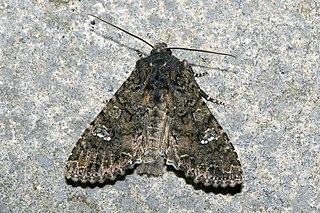
The cabbage moth is primarily known as a pest that is responsible for severe crop damage of a wide variety of plant species. The common name, cabbage moth, is a misnomer as the species feeds on many fruits, vegetables, and crops in the genus Brassica. Other notable host plants include tobacco, sunflower, and tomato, making this pest species particularly economically damaging.

Actias selene, the Indian moon moth or Indian luna moth, is a species of saturniid moth from Asia. It was first described by Jacob Hübner in 1807. This species is popular among amateur entomologists and is often reared from eggs or cocoons that are available from commercial sources. They fly mainly at night.

Acherontia styx, the lesser death's head hawkmoth or bee robber, is a sphingid moth found in Asia, one of the three species of death's-head hawkmoth. It is very fond of honey, and bee keepers have reported finding dead moths in their hives as a result of bee stings. They can mimic the scent of bees so that they can enter a hive unharmed to get honey. Their tongue, which is stout and very strong, enables them to pierce the wax cells of the beehive and suck the honey out. They are also known to be a pest of yuzu in South Korea, using their tongue to pierce and damage the fruit.

Daphnis nerii, the oleander hawk-moth or army green moth, is a moth of the family Sphingidae. It was described by Carl Linnaeus in his 1758 10th edition of Systema Naturae.

Hippotion celerio, the vine hawk-moth or silver-striped hawk-moth, is a moth of the family Sphingidae. It was described by Carl Linnaeus in his 1758 10th edition of Systema Naturae.

Mythimna separata, the northern armyworm, oriental armyworm or rice ear-cutting caterpillar, is a moth of the family Noctuidae. It is found in China, Japan, South-east Asia, India, eastern Australia, New Zealand, and some Pacific islands. It is one of the major pests of maize in Asia. The species was first described by Francis Walker in 1865.

Macroglossum divergens, the broad-bordered hummingbird hawkmoth, is a moth of the family Sphingidae. It was described by Jean Baptiste Boisduval in 1875. It is found from north-eastern Sikkim, India across southern China to Cheju Island, southern Japan, Taiwan and the Philippines and then south through Vietnam, Thailand, Malaysia and Indonesia to New Guinea and neighbouring islands. It may be in Sri Lanka.
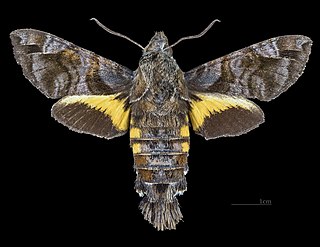
Macroglossum insipida, the hermit hummingbird hawkmoth, is a moth of the family Sphingidae. It was described by Arthur Gardiner Butler in 1875.
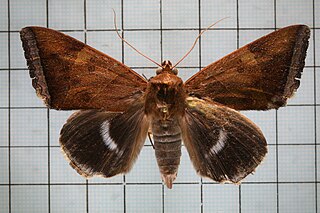
Artena dotata is a species of moth of the family Erebidae. It is found from the Indian subregion to Sri Lanka, Taiwan, Japan, Sumatra and Borneo.

Eudocima phalonia, the common fruit-piercing moth, is a fruit piercing moth of the family Erebidae. The species was first described by Carl Linnaeus in his 1763 Centuria Insectorum. It is found in large parts of the tropics, mainly in Asia, Africa and Australia but introduced into other areas such as Hawaii, New Zealand and the Society Islands. It is one of major fruit pests in the world.
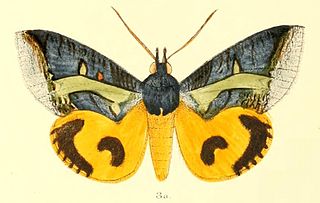
Eudocima homaena is a moth of the family Erebidae first described by Jacob Hübner in 1816. It is found in the Indian subregion, Sri Lanka, Myanmar, Taiwan, the Nicobars, Peninsular Malaysia, Borneo, the Philippines and on Christmas Island. It is a major pest on orange plants.

Eudocima salaminia, the green fruit-piercing moth, is a moth of the family Erebidae. The species was first described by Pieter Cramer in 1777. It is found from India, and across south-east Asia to the Pacific Islands. In Australia it occurs in the Northern Territory, Queensland and New South Wales. The adult is a fruit piercer.

Urapteroides astheniata is a moth of the family Uraniidae first described by Achille Guenée in 1857. It is found in south-east Asia, from India, Sri Lanka to Fiji, including New Guinea and the tropical north of Australia.

Rhagastis albomarginatus is a moth of the family Sphingidae.

Ambulyx substrigilis, the dark-based gliding hawkmoth, is a species of moth of the family Sphingidae. It was described by John O. Westwood in 1847.

Serrodes campana is a species of moth of the family Erebidae first described by Achille Guenée in 1852. It is found from the Indo-Australian tropics to eastern Australia, Fiji, Samoa and New Caledonia. It is also present in Japan, Korea and Sri Lanka. The adult is a fruit piercer, but also feeds on flower nectar.

Cyana peregrina is a moth of the family Erebidae. It is found in India and Sri Lanka. The habitat consists of forests.

Ischyja manlia is a species of moth of the family Noctuidae first described by Pieter Cramer in 1776. It is found in the Indian subregion, Sri Lanka, Myanmar, Thailand, China, Okinawa, Sundaland, Sulawesi, Korea, the southern Moluccas, Australia (Queensland) and Palau. Adults pierce the skin of fruit to suck the juice.
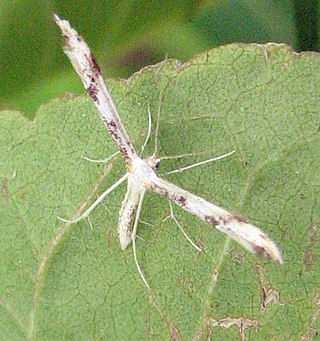
Adaina montanus is a moth of the family Pterophoridae. It is found in North America, including south-eastern Canada and the north-eastern United States.

Gadirtha fusca is a moth of the family Nolidae. It is found in east-central and south-eastern China.

























